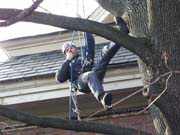Rick Rataj was one of nine smokejumpers who helped hunt down the Asian Longhorned beetle in Newport last Tuesday morning.
“Climbing trees in Jersey City is different from climbing trees out in the West,” commented Rataj, a Californian who has worked for the Forestry Service for nine years. For the last three years, Rataj has worked as smokejumper.
“Smokejumpers are forest firefighters who climb trees to retrieve firefighting equipment that has been dropped from airplanes and becomes caught in trees,” Rataj explained, adding that his work puts him in regular contact with raging forest fires.
Members of the Public Service Electric & Gas’ Division of Forestry joined Rataj on the hunt Tuesday. State law requires PSE&G technicians to be present when tree inspections near power lines are being conducted.
“But working in Jersey City is like a vacation,” Rataj said. “I get to climb trees all day and then hang out in New York City.”
According to Barry Emens, project supervisor for the United States Department of Agriculture’s Asian Longhorned Beetle eradication project, none of the 19 trees inspected on Tuesday on 10th Street near Hamilton Park were found to be infested with the tree-devouring vermin.
“Every one of the trees down there turned out to be great,” said Emens on Wednesday. “We’ve checked parks like Pershing and River View in Jersey City and parks in Hoboken. Next week, we’ll be checking out Stevens University for any infestation.”
Working mostly on the West Coast, Rataj works mainly with conifer or pinecone baring trees. Climbing the wide variety of maples and London planes, which are the usual victims of the beetle, was a new experience for Rataj.
“The deciduous trees have a lot more limbs that you have to climb on to check for infestation,” said Rataj. “I like it, though. Working here uses my rock climbing training.”
Rataj said that he has loved climbing trees since he was a child. He decided early to join the Forestry Service, allowing him to combine fire fighting with tree climbing. In 2000, Rataj began training as a smokejumper, a select group among forest firefighters.
“Training to be a smoke jumper is like going into the military,” said Rataj, comparing the training process to boot camp. “They look for people who already have firefighting experience, which I had.”
Among the skills Rataj learned was parachuting, and proper landing skills after a jump. Though his job almost regularly puts him in life-threatening situations, Rataj seemed confident about the dangers he faces.
“I’m just like a regular firefighter who has to go into a burning building,” Rataj said. “I enjoy the rush of fighting the fire.”
Regarding the ongoing anti-Asian Longhorned Beetle offensive, a total of 201 trees have removed from the Newport Parkway area, according to Emens. The inspection of the Hamilton Park area is the final part of tree inspections in Jersey City for the time being.
“Replacement trees for the Newport Parkway area have already been delivered to the site,” said Emens. “The new trees are red pear trees, which are not host trees for the Asian Longhorned Beetle.” Work on planting those trees will begin in spring, Emens added, noting the ground has at least a foot of frost on it at the present time, making it difficult for planting.
“The next phase is the chemical insecticide deployment,” said Emens. “In most cases, the insecticide will be injected into the ground around the trees.”
In a few cases, the insecticide will have to be injected directly into the trees themselves. Emens noted that approximately 93 percent of possible host trees in the contaminated area will have the insecticide injected into the surrounding soil.
First found last year
The Asian Longhorned Beetle was first discovered in the Newport area in October of 2002, when a local resident saw one of the creatures flying from one tree limb to another.
With the report of the beetle infestation of that section, the New Jersey Department of Agriculture quickly declared it a quarantine zone, said Carl Schulze, acting director for the NJDA’s Division of Plant Industry.
“No wood or timber can be removed from the area,” Schulze said. “This is to prevent the further spread of the insect.”
In its current form, the quarantine area goes from 11th Street in Hoboken to Grand Street in Jersey City. The Hudson River is the eastern end of the quarantined area, with the westward extension to Summit Avenue.
First brought to the United States in shipping crates from China, the Asian Longhorned Beetle consumes hardwood trees, presenting a serious threat to area trees like the maple.
